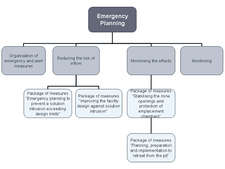BfS reports on emergency planning
More than 100 citizens at public briefing in Remlingen
end 2010.04.27
location Remlingen

![]() Michael Hoffmann (BfS) presented the BfS emergency plans for the Asse II mine
Michael Hoffmann (BfS) presented the BfS emergency plans for the Asse II mine
What exactly is an emergency and what will happen then in the Asse II mine? Michael Hoffmann, temporary head of the department “Safety of Nuclear Waste Management” of the Federal Office for Radiation Protection (BfS) explains this in simple terms: “We’ve got an emergency when more water flows into the mine than can be pumped off
.” In that case it is not possible to carry on with the structured operation of the mine.
BfS presented emergency planning
More than 100 citizens took part in the BfS public briefing that took place at the Remlingen community centre on 27 April 2010. “The BfS presented the emergency plans. They will be updated continuously
,” Hoffmann said.

![]() Michael Hoffmann and Matthias Ranft (BfS), Jens Köhler and Harald Hegemann (Asse-GmbH) answered questions relating to the emergency plans
Michael Hoffmann and Matthias Ranft (BfS), Jens Köhler and Harald Hegemann (Asse-GmbH) answered questions relating to the emergency plans
Already today the BfS is working on limiting the consequences of an emergency. For example, in more than 80 chambers where no nuclear waste has been stored the clefts between the backfilled salt and the roof have been filled with concrete. Furthermore galleries in the mine are being covered with concrete, too. This will stabilise the mine. For the case that larger amounts of water should flow into the Asse mine nevertheless, emergency storage facilities have been established, the emergency reservoirs have been expanded and the solution management has been improved. Thus it has been regulated in contracts that up to 500 cubic metres of influent saline solution per day can be removed from the Asse mine to other places. Furthermore BfS intends to establish four new reservoirs on the 800-m level at the very bottom of the mine with volumes of 1,400 cubic metres each.
Emergency planning will be updated continuously
For precautionary reasons, additional galleries around the emplacement chambers will be closed with massive masonry constructions (so-called flow-barriers). When it can be recognised that the inflow of saline solution is out of control, the emplacement chambers themselves will be backfilled. Following this, the shafts will be sealed with special sealing elements made from Sorel concrete and bitumen. Only then is it planned to flood the remaining cavities of the mine with a special solution. This special solution prevents the salt rocks from dissolving. Otherwise the conditions in the Asse mine would be out of control.
It is not possible to give a more precise point in time defining the occurrence of an emergency. In the Q&A session Hoffmann and Ranft made clear that in case of emergency the operator would have to take a decision in close co-operation with the federal and Länder regulatory bodies. With taking over the operatorship of the Asse mine in 2009 the BfS had started preparing the emergency plans according to nuclear law. These plans had not been available before. Already in the summer of 2009, the BfS presented for the first time the conception of emergency plans for the Asse II mine. These considerations have meanwhile been continuously advanced. As agreed on, the BfS concluded its concrete emergency plans at the end of February 2010.
Address
38319 Remlingen
Germany


